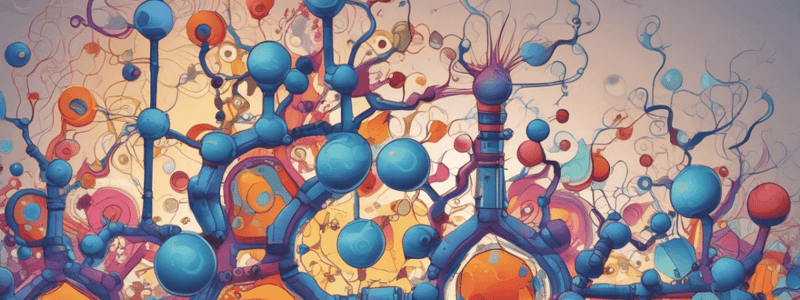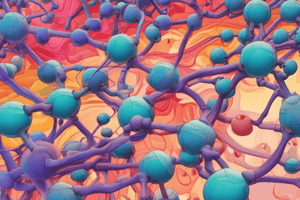Podcast
Questions and Answers
What is the primary mechanism governing the increase in chain length in addition polymerisation?
What is the primary mechanism governing the increase in chain length in addition polymerisation?
- Bifunctional species
- Free radical mechanism (correct)
- Condensation reaction
- Ionic species
What type of compounds are used as monomers in addition polymerisation?
What type of compounds are used as monomers in addition polymerisation?
- Unsaturated compounds (correct)
- Alkynes
- Aromatic compounds
- Saturated hydrocarbons
Which type of polymerisation involves the formation of a distinct functionalised species in each step?
Which type of polymerisation involves the formation of a distinct functionalised species in each step?
- Copolymerisation
- Condensation polymerisation
- Step-growth polymerisation (correct)
- Addition polymerisation
What is the outcome of each step in step-growth polymerisation?
What is the outcome of each step in step-growth polymerisation?
Which type of polymerisation results in a significant increase in chain length?
Which type of polymerisation results in a significant increase in chain length?
What is an example of a reaction that involves the addition of molecules of the same monomer?
What is an example of a reaction that involves the addition of molecules of the same monomer?
What is the characteristic of Cross-linked or Network Polymers?
What is the characteristic of Cross-linked or Network Polymers?
What type of polymerisation is involved in the formation of polythene from ethene?
What type of polymerisation is involved in the formation of polythene from ethene?
What is the characteristic of Addition Polymers?
What is the characteristic of Addition Polymers?
What is the type of polymer formed by the polymerisation of two different monomers?
What is the type of polymer formed by the polymerisation of two different monomers?
What is the catalyst used in the formation of Buna-S?
What is the catalyst used in the formation of Buna-S?
What is the type of polymerisation involved in the formation of Bakelite?
What is the type of polymerisation involved in the formation of Bakelite?
What is the primary characteristic of Melamine-Formaldehyde polymer that makes it suitable for producing unbreakable crockery?
What is the primary characteristic of Melamine-Formaldehyde polymer that makes it suitable for producing unbreakable crockery?
Which type of polymerisation reaction is characterized by the formation of a distinct functionalized species in each step?
Which type of polymerisation reaction is characterized by the formation of a distinct functionalized species in each step?
What is the primary difference between cis-polyisoprene and trans-polyisoprene?
What is the primary difference between cis-polyisoprene and trans-polyisoprene?
Which type of polymerisation reaction involves the reaction of two or more different monomeric species?
Which type of polymerisation reaction involves the reaction of two or more different monomeric species?
What is the primary reason for the elasticity of natural rubber?
What is the primary reason for the elasticity of natural rubber?
Which type of polymerisation reaction is used to produce phenol-formaldehyde polymers?
Which type of polymerisation reaction is used to produce phenol-formaldehyde polymers?
What is the primary mechanism governing the formation of polymers in addition polymerisation?
What is the primary mechanism governing the formation of polymers in addition polymerisation?
What is the characteristic of Low Density Polythene (LDP)?
What is the characteristic of Low Density Polythene (LDP)?
What is the primary outcome of each step in addition polymerisation?
What is the primary outcome of each step in addition polymerisation?
Which of the following is an example of an addition polymer?
Which of the following is an example of an addition polymer?
What is the role of benzoyl peroxide in addition polymerisation?
What is the role of benzoyl peroxide in addition polymerisation?
Which type of polymerisation is characterised by the formation of a free radical?
Which type of polymerisation is characterised by the formation of a free radical?
What is the primary difference between addition and condensation polymerisation?
What is the primary difference between addition and condensation polymerisation?
What is the primary difference between High Density Polythene (HDP) and Low Density Polythene (LDP)?
What is the primary difference between High Density Polythene (HDP) and Low Density Polythene (LDP)?
Which type of polymerisation is used to produce polymers with high molecular weights?
Which type of polymerisation is used to produce polymers with high molecular weights?
What is the outcome of chain termination in addition polymerisation?
What is the outcome of chain termination in addition polymerisation?
What is the primary mechanism governing the increase in chain length in condensation polymerisation?
What is the primary mechanism governing the increase in chain length in condensation polymerisation?
Which type of polymerisation is characterised by the formation of a polymer with a high molecular weight in a single step?
Which type of polymerisation is characterised by the formation of a polymer with a high molecular weight in a single step?
What is the primary characteristic of polymers formed through addition polymerisation?
What is the primary characteristic of polymers formed through addition polymerisation?
What is the primary difference between homopolymers and copolymers?
What is the primary difference between homopolymers and copolymers?
What is the primary characteristic of Cross-linked or Network Polymers?
What is the primary characteristic of Cross-linked or Network Polymers?
What is the primary mechanism of chain growth in addition polymerisation?
What is the primary mechanism of chain growth in addition polymerisation?
Which type of polymerisation is involved in the formation of polythene from ethene?
Which type of polymerisation is involved in the formation of polythene from ethene?
What is the primary characteristic of polymers formed through condensation polymerisation?
What is the primary characteristic of polymers formed through condensation polymerisation?
Flashcards are hidden until you start studying
Study Notes
Types of Polymerisation Reactions
- Polymerisation reactions can be classified into three types: Addition, Condensation, and Copolymerisation
- Addition polymerisation involves the addition of monomers to form a polymer, resulting in an increase in chain length
- Condensation polymerisation involves the formation of a polymer through the condensation of monomers, resulting in the loss of a small molecule such as water or methanol
- Copolymerisation involves the polymerisation of two or more different monomers to form a copolymer
Addition Polymerisation
- Addition polymerisation involves the addition of monomers to form a polymer, resulting in an increase in chain length
- The mechanism of addition polymerisation involves three steps: initiation, propagation, and termination
- Initiation involves the formation of a free radical, which then reacts with a monomer to form a larger radical
- Propagation involves the repeated addition of monomers to the growing radical chain
- Termination involves the combination of two radicals to form the final polymer product
Homopolymers and Copolymers
- Homopolymers are formed by the polymerisation of a single monomer species
- Examples of homopolymers include polythene, polypropylene, and polyacrylonitrile
- Copolymers are formed by the polymerisation of two or more different monomers
- Examples of copolymers include Buna-S and Buna-N
Chain Growth and Step Growth
- Chain growth polymerisation involves the addition of monomers to form a polymer, resulting in an increase in chain length
- Step growth polymerisation involves the formation of a polymer through the condensation of monomers, resulting in the loss of a small molecule such as water or methanol
- Chain growth polymerisation can take place through the formation of either free radicals or ionic species
- Step growth polymerisation is also known as condensation polymerisation
Characteristics of Polymers
- Polymers can be classified based on their molecular structure, such as branched-chain, linear, and cross-linked polymers
- Branched-chain polymers are formed from monomers with multiple functional groups
- Linear polymers are formed from monomers with a single functional group
- Cross-linked polymers are formed from bifunctional and trifunctional monomers
- Cross-linked polymers contain strong covalent bonds between various linear chains
Examples of Polymers
- Low density polythene (LDP) is a branched-chain polymer formed from the polymerisation of ethene under high pressure and temperature
- High density polythene (HDP) is a linear polymer formed from the polymerisation of ethene in a hydrocarbon solvent
- Polyacrylonitrile (PAN) is a polymer formed from the polymerisation of acrylonitrile
- Polytetrafluoroethene (PTFE) is a polymer formed from the polymerisation of tetrafluoroethene
- Bakelite and Melamine are examples of cross-linked polymers
Studying That Suits You
Use AI to generate personalized quizzes and flashcards to suit your learning preferences.





